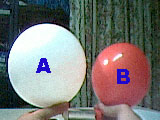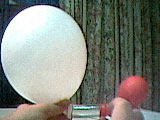


|
David and Goliath
Science at Home |
||
|
Materials
|
|
Videos: download.avi (182 KB)
Pictures: 

|
|
Procedure
1. Fill a balloon with air until it has about three forth of the total volume. (this is the Goliath balloon) 2. Press the mouth of the Goliath balloon and place it in one of the extremities of a rubber tube. Don't let the air escape. 3. Fill the other balloon with air until it has about a quarter of the total volume. (this is the David balloon) 4. Press the mouth of the David balloon and link it to the other extremity of the tube. Don't let the air escape. 5. Simultaneous, with the two hands, unpress the mouths of the balloons and verify who wins. Was it David or Goliath? |
||
|
Why?
The tangent elastic forces that act in a small elastic surface has a stronger component in the balloon center direction when it has less air in comparison with the practically full. Therefore, it is more difficult to fill a balloon in the beginning than to continue to fill it when it is already expanded. As you could notice, the balloon of smaller size (David) has a smaller curvature than the other balloon (Goliath). Thus, in the smallest balloon surface (David), a higher resultant force exists in direction to the center (air with more pressure). Due to the fact that the air always moves from high to the low pressures, the small balloon (David) fills the big balloon (Goliath). As can you see, science is in agreement with the mythology, in other words, the small balloon (David) had more strength than the big balloon (Goliath). Don't forget to try! And win bets with your friends! |
||
 |
No part of this website can be reproduced without previous authorization. Please inform me if there is any problem with the website. |